 klaus-michael schneider
klaus-michael schneider
Keywords: education |
Links: FOTW homepage | search | disclaimer and copyright | write us | mirrors

Last modified: 2021-08-26 by  klaus-michael schneider
klaus-michael schneider
Keywords: education |
Links: FOTW homepage |
search |
disclaimer and copyright |
write us |
mirrors
See Also:
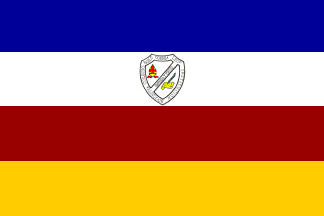 image by Ivan Sache, 12 July 2014
image by Ivan Sache, 12 July 2014
Institución Educativa Colegio Pablo Correa León was established on 20 March
1980 in Cúcuta (Norte de Santander Department). The institute is named for Pablo
Correa León (1918-1980), 2nd Bishop of Cúcuta (22 July 1959 - 27 July 1970).
The flag of the institute is horizontally divided dark blue-white-wine
red-gold with the institute's emblem in the white stripe. There is no
photographic evidence that the flag in actual use bears the emblem. Dark blue is
a symbol of great ideals. White is a symbol of peace, harmony, transparency,
legality, human relations, respect for all, and dignity. Wine red is a symbol of
tenacity, audacity, and perseverance. Gold is a symbol of human values.
http://majitouribe91.blogspot.fr/2013/05/bandera-colegio-pablo-correa-leon.html
- María José Uribe Silva's blog
The emblem of the institute is a shield
diagonally divided per bend sinister. The upper part, white, is charged with a
mitre, as a tribute to Bishop Pablo Correa León and a symbol of the Christian
faith. The mitre is yellow, with a red cross and lappets (infulae). The sinister
part, blue [white on the drawing] is charged with a yellow parchment and a green
quill, symbolizing science and truth. The bend is charged with the institute's
motto, "EMPRESA Y VIRTUD" ('Enterprise and Virtue).
http://majitouribe91.blogspot.fr/2013/05/escudo-colegio-pablo-correa-leon_1.html
- María José Uribe Silva's blog
Ivan Sache, 12 July 2014
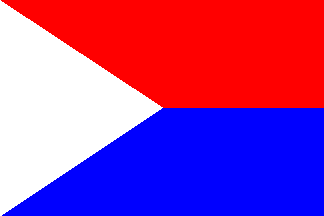 image by Ivan Sache, 27 January 2009
image by Ivan Sache, 27 January 2009
"Colegio 'Pablo de Tarso'" (Paul of Tarsus) was
founded in January 1996 by the Federal District of Bogotá
(Decree No. 002).
The flag of the institute, as shown graphically on the website
of the institute, is horizontally divided red-blue with a
white triangle placed along the hoist.
Ivan Sache, 27 January 2009
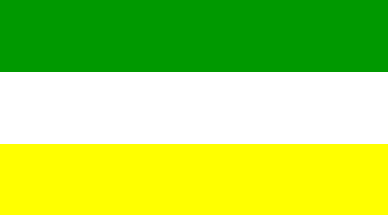 image by Ivan Sache, 01 July 2014
image by Ivan Sache, 01 July 2014
Colegio Diocesiano Paulo Sexto is located in Cereté (Córdoba Department). The
institute is named for Pope Paul VI.
The flag of the institute is horizontally divided green-white-yellow.
Source:
http://unminutoparalareflexion2013.blogspot.fr/2014/04/himno-del-colegio-diocesano-pablo-sexto.html
- Nabonazar Cogollo Ayala's blog
Ivan Sache, 01 July 2014
 image by Ivan Sache, 27 July 2018
image by Ivan Sache, 27 July 2018
Colegios Padre Manyanet were established in Medellín, Bogotá and Chía by
the Sons of the Holy Family, a congregation founded in 1864 by St. Josep
Manyanet i Vives (1833-1901; canonized on 16 May 2004 by Pope John Paul II).
The flag of Colegios Padre Manyanet is described in Chapter 6.1. of the
schools' Manual de Convivencia, as follows.
The flag of Colegio Padre
Manyanet, used worldwide by the Sagrada Familia, is horizontally divided
purple-white-blue.
Purple represents St. Joseph.
White represents Jesus.
Celestial blue represents the Blessed Virgin.
https://www.padremanyanet.edu.co/paginas/documentos/CONVIVENCIA.pdf
Manual de Convivencia
Ivan Sache, 27 July 2018
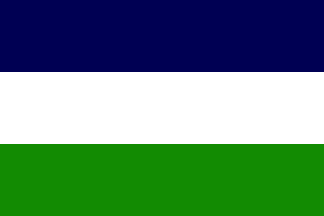 image by Ivan Sache, 07 July 2018
image by Ivan Sache, 07 July 2018
Institución Educativa Padre Roberto Arroyave Vélez was established in San
Pedro de los Milagros, as Escuela Pública del Distrito Municipal, by a Decree
issued on 22 October 1821 by the Sovereign Congress of Colombia. The school was
renamed in 1984 as a tribute to Father Roberto Arroyave Vélez, founder of
Escuela Normal Señor de los Milagros and of Liceo Departamental Pio XII.
The flag of IE Padre Roberto Arroyave Vélez is described as follows:
A. A royal blue upper stripe, meaning loyalty, confidence, knowledge, cleverness,
faith, and truth.
B. A white stripe, associating light, kindness, purity, perfection, and peace.
C. A green lower stripe, symbolizing the color of natural environment. It
represents harmony, growth, and hope.
Source:
Manual de Convivencia, Chapter 1.7.1
Ivan Sache, 07 July 2018
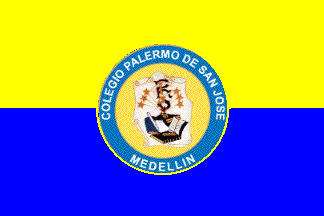 image by Ivan Sache, 30 June 2014
image by Ivan Sache, 30 June 2014
Colegio Palermo de San José was established on 17 January 1943 by Antonio
Henao (d. 1986), the parish priest of El Pobladao (Medellin) and Mother María
Olivia (1918-2004), an Austrian-born nun from the Congregation of the Franciscan
Missionary Sisters of Mary Help of Christians, established in Ecuador by the
Swiss-born nun St. Maria Bernarda Bütler (1848-1924; canonized on 12 October
2008 by Pope Benedict XVI). Blessed on 19 March 1943, St. Joseph's Day, the
institute was relocated in 1945 in the Palermo estate, purchased one year
before.
The flag of the institute is presented as horizontally divided yellow-blue. The
image shows the institute's emblem in the middle of the flag, while the written
description mentions only the two stripes. There is no photographical evidence
that the flags in actual use are charged with the emblem.
Yellow is a symbol of the love for the Eucharist, of struggle for surpassing,
and of universal fraternity. Blue is a symbol of love for Mary Help of
Christians.
The emblem of the institute was designed by Sister Gregoria Dücks. It is made of
a yellow disk with a blue border inscribed with "COLEGIO PALERMO DE SAN JOSE"
(top) and "MEDELLIN" (bottom). Inside the disk is a white parchment, a symbol of
truth and transparency. The yellow stars represent high ideals and goals. The
lamp is a symbol of force and tenacity, of the light of Christ, of enthusiasm,
joy, and Franciscan kindness. The monogram refers to the name of the institute.
The books are a symbol of science.
Source:
http://www.palermosj.edu.co/PortalExtranet/Default.aspx?TabIndex=1&TabId=976
Ivan Sache, 30 June 2014
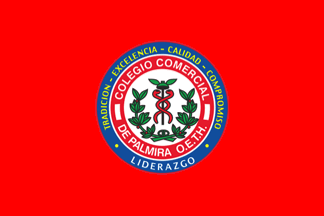 image by Ivan Sache, 1 January 2021
image by Ivan Sache, 1 January 2021
Colegio Comercial de Palmira OETH (CCDPOETH) joined on 1 July 2009
Organización Educativa Tenorio Herrera (OETH), a company established by Mercedes
Herrera Mora de Tenorio.
The original Colegio Comercial de Palmira was
established on 1 May 1945 by Helga Garcia Cabal, who owned and managed it until
30 March 2009.
The Municipality of Palmira approved on 10 March 2010 the sale
of the school and its new name.
https://www.colegiocomercialdepalmiraoeth.edu.co
CCDPOETH website
The flag of CCDPOETH is red with the school's emblem in the center.
https://www.colegiocomercialdepalmiraoeth.edu.co/mi-ccdpoeth/sobre-nosotros/simbolos;
CCDPOETH website
Photos
https://www.editorialmercedesherrerasas.com/eventos/las-mujeres-de-la-oeth
https://www.facebook.com/Colegiocomercialdepalmiraoeth/photos/3775976285759319
https://www.facebook.com/Colegiocomercialdepalmiraoeth/photos/3151568844866736
https://www.facebook.com/Colegiocomercialdepalmiraoeth/photos/2297989573558005
https://www.facebook.com/Colegiocomercialdepalmiraoeth/photos/168065280195835
Ivan Sache, 1 January 2021
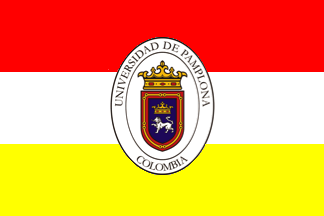 image by Ivan Sache, 20 October 2017
image by Ivan Sache, 20 October 2017
Image based on www.unipamplona.edu.co.
Dov Gutterman, 21 July 2002
The University was established on November 23, 1960 as a a public,
departmental, coeducational research University based primarily in the city of
Pamplona, Norte de Santander, Colombia. The university also has two satellite
campuses in the department, in the cities of Cúcuta
and Villa del Rosario.
Sources:
http://www.unipamplona.edu.co/unipamplona/portalIG/home_1/recursos/01_general/pagina_ingles/17122013/resena_historica.jsp
and
https://en.wikipedia.org/wiki/University_of_Pamplona
Its flag design
is very simple: it is the color of the Municipality of
Pamplona after which it gets its name, with the University's coat of arms (https://es.wikipedia.org/wiki/Universidad_de_Pamplona#/media/File:Escudo_Universidad_de_Pamplona.svg)
in the middle.
Esteban Rivera, 19 October 2017